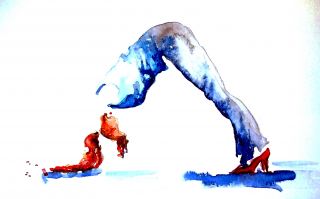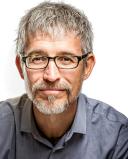Creativity
The Science of Creative Insight & Yoga
3 correlations between yoga & creativity can lead to future studies.
Posted November 21, 2012

Red Shoes Yoga Lady by Donna Mullholland
Yoga aids creativity? At first pass, that claim might seem a New Age stretch. Sure, Sting, rap mogul Russell Simmons, Sarah McLaughlin, Ellen Gilchrist, Tom Robbins, and countless other renowned creatives consider yoga among their musing allies. And, yes, yoga screwed up my writer’s life several years ago. Werner Herzog, on the other hand, notably thinks yoga is stupid.
So, how does yoga - specifically Hatha Yoga, the branch that emphasizes physical postures, movements, and harnessed respiration - help people be more creative?
New York Times science editor William Broad pursued a related question in “Muse,” the last chapter of his book The Science of Yoga: The Risks and the Rewards (Simon & Schuster, 2012):
What does science show about yoga’s effects on the muse?
Broad himself, a Pulitzer Prize-winning journalist who’s spent harried days in war trenches, has been practicing yoga since 1973, and he attributes the practice in part to his equanimity on the job for so long.
Studying the science of creativity is difficult by itself. But studying yoga and creativity scientifically? Definitely not simple. In the chapter “Muse,” “By definition,” Broad admits, “the research [in creativity and yoga] is much more difficult to do properly than measuring hormones and muscle tension, brain waves and blood pressure” and that “Science tends to do the easiest things first.” Hence, there’s not a lot of data that links the two directly.
Creativity is not just about “inspiration” - as Broad unfortunately implies - but let’s start with one related area of creativity: ideation and insight. Namely, how does physical yoga contribute to creative people’s capacity to become aware of and capture novel ideas, images, and insights?
Ideo-genesis & Image-genesis
The perfect metaphor for a song, brand, scientific concept (a man surfing on a wave of light) or story arises through brave novel combos.
How does a person regularly feel that state where an idea becomes an image, where a feeling becomes an idea, where an idea becomes entwined with a feeling?
From a scientific view, the first question might be, “What part of the brain lights up when a person gets a ‘eureka’ solution? And what activities or habits can lead to the mind and the brain generating more such novel combinations?”
Possible correlation paths to pursue:
PATH 1: A relaxed but alert state of mind
Brainwave correlates: Mark Beeman of Northwestern University have identified two patterns in successful problem-solvers’ brains. These patterns became so predictable that the scientists could predict within seven seconds which of the participants would solve the word puzzles posed.
Relevant finding: Successful problem-solvers’ brain waves slowed down to an oscillating rhythm identified as alpha band waves for a prolonged period. This period extends until just before a person lands on a "eureka" discovery solution. This pattern describes the oscillating rhythm that Electroencephalography can measure in a person’s frontal cortex.
Watching a person’s brain waves graph is generally like taking a general picture of a person’s state of cognition. Brain wave patterns that oscillate at a high frequency approximately 13-36 oscillations/second are called beta brain waves. This pattern usually shows up when the human mind analyzes information, gets stressed, busily preoccupies itself, or multi-tasks.
Alpha wave patterns, on the other hand, appear when the mind is relaxed yet alert. Oscillations pulse at half the alpha rate: approximately 6-13 oscillations/second. When a runner flies in flow, a surgeon cuts in flow, a musician blows or strums in flow, or a chess player maneuvers in flow, I would wager each of their brains’ frontal cortices reflect alpha rhythms.
Possible correlations: Since the 1970s, scientists have measured brain waves of various meditators (yogis and others). Studies consistently show that meditators’ brains can slow from beta to alpha within minutes - some of them even amidst distraction and noise.
But what about other tools of Hatha Yoga such as sequences of postures and harnessed breath work?
The most consistent studies that I cited originally in The Journey from the Center to the Page (2004; 2008) and that Broad followed up with in more detail in The Science of Yoga (2012) center on the work of Elmer and Alyce Green.
In 1973, the Greens met yogi Ram Sharma. Ram Sharma could slow down his brain wave patterns within minutes not only to the alpha rhythm but also to an even slower rhythm called theta. Before the Greens’ study, the theta state had only been associated with the dream or REM state. The encounter amazed and inspired the Greens. (Prof. Ram Sharma describes his Anand Yoga technique in detail.)
These founders of Clinical Biofeedback trained college students to relax their bodies, pay attention to their body sensations, and harness their breathing into regular rhythms. They measured the brain wave patterns and the problem-solving results.
The results? Brain waves slowed down not only to the alpha state but also showed traces of theta wave patterns - an even slower rhythm that suggests that the brain’s hyper-rational “executive decision-maker” network is quiet enough for other parts of the brain we might associate with the mind’s unconscious to be aroused.
With this training, college students reported remarkable insight and solutions to problems.
In fact, despite what some writers on the science of creativity continue to purport about alpha waves and creativity, Green suggests that theta, not alpha, is the brain wave state to focus on for real creativity. Journalist-cum-business fitness consultant Tony Schwartz studied biofeedback with Green, and in his book What Really Matters he quotes Green as saying, “If you want to truly grow, the only way you’re going to do that is through the deeper state of theta. That’s where you can interrogate the unconscious and even gain the ability to reprogram it. The true value of alpha is that it’s a necessary bridge between beta and theta.”
Green’s biofeedback process is comparable to ancient yogic practice called Yoga Nidra (or “The Yoga of Deep Sleep”) in which a person is deeply relaxed and yet aware of what is happening in the mind and body.
A study by Hans C. Lou et al in 1999 concluded that Yoga Nidra quiets the prefrontal region and arouses the posterior visual system - a state of awareness comparable to REM sleep.
The practices:
- Savasana (Corpse) Posture: Anyone who’s taken a standard yoga class in the West probably knows (and loves) this posture that often closes a class. Laying on your back, you might be instructed to relax your muscles with awareness, close your eyes, and ease your breathing. Sometimes within minutes, you might “see” with eyes closed fleeting dream-like images or hear dream-like sounds.
- Watch your dreams: A traditional yoga practice, Yoga Nidra, is to remain in Corpse Posture posture for several minutes while a teacher guides your attention to different points in the body. The purpose is for the teacher’s voice to occupy the conscious mind’s attention on parts of the body that then allows the rest of the mind to relax. Hence, “relaxed but alert.” Green’s biofeedback methods refined the process, and clinical psychologist, yogic scholar, and spiritual teacher Richard C. Miller founded the Integrative Restoration Institute expressly to train others in a modified version of Yoga Nidra he calls iRest.
- Get to the Mat: What precedes the practices above typically are some mindful yoga postures and sequences. A study in 2000 correlates the decrease in serum cortisol that a yoga exercise consistently has been shown to produce with stimulating the alpha wave rhythm.
- Breathing from the Gut: As early as 1972, a pioneer in “respiratory psychophysiology” Barbara Timmons correlated states of “relaxed wakefulness” with breathing by activating the abdomen instead of the chest area (as people untrained in harnessed breathing typically do).
Second relevant finding:
PATH 2: Idea-genesis is still a right-brained thing.
The findings in creativity: Although I’ve attempted elsewhere to debunk simplistic right-left-brain thinking, several studies continue to point to the right hemisphere’s role in generating novel ideas and insights. Studies led by Jonathan Schooler (UC Santa Barbara) and Jon Kounios (Drexel University) demonstrate that the part of the brain that lights up during Aha! moments is the right anterior temporal lobe. It’s located in the right hemisphere, generally behind the right ear.
At the moment insight, the brain waves light up at the highest measurable frequency known as gamma waves - potentially associated with "higher thinking" such as meditation.
Two findings in yoga: Andrew Newberg of the University of Pennsylvania Medical Center and his team studied four beginning yoga practitioners (Note: Broad also reviews this and other studies). Over several months, the practitioners underwent three months of yoga training and a specific routine. The team measured each participants’ hemispheric activity before and after the training. After three months of practice and study, practitioners’ right hemispheres were activated more.
Francois B. Vialatte (RIKEN Brain Science Institute, Laboratory for Advanced Brain Signal Processing in Tokyo, Japan) and his team measured a density of gamma waves in beginning practitioners after practicing one simple breathing exercise. The density of gamma waves appeared in the same brain region in which Richard Davidson has measured a density of gamma waves in the brains of Tibetan monks advanced in meditation practice.
The region is called the anterior cingulate cortex, and it correlates with the brain's detection of novelty and with compassion.
The practices: Forward bends are part of the routine Newberg studied. Another tool involves constricting the back of the throat, the glottis, so that breath almost sounds raspy. If practiced by relaxing the constricted throat muscles, the practice can create a similarly “relaxed but alert” state. This type of breathing was also part of the routine.
These findings, by the way, are consistent with the simple forward-bend sequence and breathing I encourage creatives to test out called The Drafting Sequence - and they’re consistent with the reports creatives give me about its positive effects.
Bumblee Breathing (or brahmari paranayama as it's known in Sanskrit) is the breathing practice that induces gamma waves as well as waves of temporary happiness & pleasure (another emotional correlate to insight that Beeman has identified).
Third relevant finding:
The calm but aroused fire carrier:
Some neuroscientists suspect that the brain’s capacity for generating new neurons (neurogenesis) and new dendrites for increased neuronal pathways (neuroplasticity) correlates with “idea genesis.”
With all of this stimulation, our brains can feel like true “brain storms” of exhausting activity. How do you stay calm while your brain fires away with new ideas and connections?
The findings: Enter the neurotransmitter called GABA, gamma-aminobutyric acid. This neurotransmitter calms down the rate at which neurons fire off their synaptical activity.
And Chris Streeter of Boston University and team found that yoga overwhelmingly spikes GABA in beginners who practice even one hour of yoga. For four weeks, participants in the study attended yoga classes each week, practiced the same sequences, and then were encouraged to practice the sequences at home. The 2010 study reportedly is “the first time that a behavioral intervention (i.e., yoga postures) has been associated with a positive correlation between acute increases in thalamic GABA levels and improvements in mood and anxiety scales.” (Note: Broad also briefly references this study.)
The practices: Study participants practiced Iyengar Yoga, a system that emphasizes precise alignment of parts of the body in singular postures, typically not taught as part of a flow but each posture by itself.
An Apology for Faulkner's Generation
I'm not suggesting that if you just try a few yoga poses and practices that you'll have instant creative insights and advance the next scientific, literary, or entrepreneurial break-through. I am suggesting we not be so quick to poo-poo the potential correlation between yoga & creativity.
Whiskey-wizened William Faulkner might have scoffed at the idea of trading his wool pants for a pair of Lulemon’s to write The Sound and the Fury. He did claim, after all, he knew nothing about inspiration. But in the same Paris Review interview he also claimed to have written the first draft of As I Lay Dying each night for six weeks. And what did he do during the day? Ostensibly several hours of physical labor.
I’m betting while the younger scribe hauled and sawed logs, his brain waves oscillated in alpha rhythms and every once in a while his right temporal lobe lit up as he captured a phrase or heard a voice that let him daydream on the job. For a Mississippi man in the 1940s, the rhythms of sawing and hauling were likely the closest he could have gotten to bliss while keeping his decency.
Fortunately, writers these days need not be so embarrassed about taking care of themselves during their otherwise reckless creative endeavors.
DROP BY
Have any of you found yoga helpful or harmful to your ability to create? Scholars, have I missed any points here?
Jeffrey




